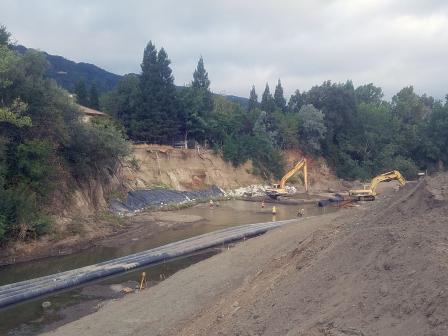Alameda Creek Restoration: Preparing for the Storm
Riparian Restoration, Sediment Reuse, and Urban Greening to Enhance Stream and Watershed Resilience
 Arroyo de la Laguna During Construction August 2017 | Click image to enlargeZone 7’s project “Preparing for the Storm” will improve the habitat, water quality and resilience of the Alameda Creek watershed. The public-private partnership will re-establish floodplains and riparian habitat along over two miles of steelhead streams through bank setbacks on vineyard property and a privately-owned golf course. The project will also restore 10 acres of riparian habitat including rare Sycamore Alluvial Woodland, reduce streambank erosion, and reuse an estimated 50,000 cubic yards/year of coarse sediment. Additionally, the project will help improve stormwater capture based on regional guidance and planning tools for the eastern Alameda County including the Livermore-Amador Valley, and connect with the local community and stakeholders through watershed groups such as the Living Arroyos watershed stewardship program, Arroyo De La Laguna Collaborative, and Alameda Creek Watershed Forum.
Arroyo de la Laguna During Construction August 2017 | Click image to enlargeZone 7’s project “Preparing for the Storm” will improve the habitat, water quality and resilience of the Alameda Creek watershed. The public-private partnership will re-establish floodplains and riparian habitat along over two miles of steelhead streams through bank setbacks on vineyard property and a privately-owned golf course. The project will also restore 10 acres of riparian habitat including rare Sycamore Alluvial Woodland, reduce streambank erosion, and reuse an estimated 50,000 cubic yards/year of coarse sediment. Additionally, the project will help improve stormwater capture based on regional guidance and planning tools for the eastern Alameda County including the Livermore-Amador Valley, and connect with the local community and stakeholders through watershed groups such as the Living Arroyos watershed stewardship program, Arroyo De La Laguna Collaborative, and Alameda Creek Watershed Forum.
Project Facts
Recipient: Zone 7 Flood Control Agency
Funding: $1,131,000 (non-federal match = $1,131,000), FFY: 2017
Project Period: July 2017 – September 2021
Partners: San Francisco Estuary Institute, H.T. Harvey & Associates, Castlewood Country Club, Concannon Vineyard, San Francisco Bay Joint Venture, Livermore Area Recreation and Park District (LARPD), Cities of Livermore, Pleasanton, Dublin, and San Ramon, Bay Area Flood Protection Agencies Association (BAFPAA), and Living Arroyos Program
|
OUTPUTS (Activities, efforts, and/or work product during project period) |
OUTCOMES (Environmental results) |
|
|---|---|---|
|
SHORT-TERM |
LONG-TERM |
|
|
Quantitative assessment of potential water quantity and quality benefits from green infrastructure Maps and tables showing the optimal locations for green infrastructure Technical memo to be added to the SMMP Update toolbox informing watershed-scale green infrastructure planning Summary of potential coarse sediment volumes for reuse Coarse Sediment Reuse Strategy memo Expanded SediMatch Website |
Cost-effective placement of green infrastructure features by Valley cities for runoff and load reductions Anticipated average of 220,000 gallons volume reduction, 0.47 cfs peak flow reduction, and 8.3 mg/acre of PCB and Hg treatment for every acre treated 10,000 cubic yards/yr of coarse sediment reused for high-value stream and potential bayland habitat improvement |
20% retrofit of existing urban infrastructure by 2040 guided by Valley-wide Vision, with annual total volume reduction of 440 million gallons, peak flow reduction of 930 cfs, and capture of 8.5g PCB and Hg Reduced PCB loading to the Bay cost-effectively through a wide range of urban greening efforts Reduce stormwater runoff through strategically-placed green infrastructure. Reuse of up to 50,000 cubic yards/yr of dredged stream sediment for stream and Bay restoration projects, facilitated through SediMatch and BAFPAA 15 acres of Sycamore Alluvial Woodland habitat restored based on Sycamore Alluvial Woodland strategy |
|
OUTPUTS (Activities, efforts, and/or work product during project period) |
OUTCOMES (Environmental results) |
|
|---|---|---|
|
SHORT-TERM |
LONG-TERM |
|
|
Vision memo for habitat restoration, bank stability, and flood control on Arroyo de la Laguna between Bernal and Verona Verona Reach final design Castlewood Hole 18 Conceptual and Final Design Technical memo summarizing potential Castlewood habitat and water quality improvements Technical memo summarizing findings, site-scale guidelines, and outcomes of Sycamore Alluvial Wetland conceptual pilot applications Brief post-project implementation and monitoring technical memo summarizing drone survey findings, change over time. |
300 ft or more of expanded floodplain, stream bank protection, and riparian forest restoration in Verona Reach 150 ft of floodplain expansion, stream bank protection, and riparian forest restoration at Castlewood Audubon Golf Course certification and associated water quality and habitat benefits on 120 acres at Castlewood Over 10,000 linear feet of Arroyo Mocho assessed for Sycamore Alluvial Woodland restoration 1500 ft of riparian restoration, including 5 acres of improved riparian habitat (including oak woodland) at Medeiros Parkway Estimated 3000-4000 cubic yards/yr increased natural sediment storage on floodplain at Medeiros Parkway 10 acres of new floodplain inundation and groundwater recharge at Concannon Vineyard |
1 mile of riparian setbacks, riparian forest restoration, or floodplain buffers along Arroyo De La Laguna to improve erosion and water quality Increased acreage of riparian restoration and bank setbacks Reduction of contaminants and increase in wildlife habitat along Arroyo De La Laguna Increased groundwater recharge, instream and riparian habitat, and sediment storage 1300 ft of riparian forest restoration at Concannon Vineyard 10 acres of riparian restoration including SAW and riparian oak woodland enhancements along Arroyo Mocho in Livermore. |
|
OUTPUTS (Activities, efforts, and/or work product during project period) |
OUTCOMES (Environmental results) |
|
|---|---|---|
|
SHORT-TERM |
LONG-TERM |
|
|
Outreach materials for six (6) volunteer day Three (3) Public Presentations Project web page(s) that include links to final products and web maps and documents |
100 volunteers, or members of the public educated about or participating in “Preparing for the Storm” |
|
Full List of Project Summaries
